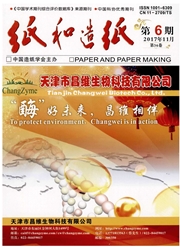

 中文摘要:
中文摘要:
利用粉煤灰联产新型硅酸钙填料(FACS)是高值化利用粉煤灰的有效途径。本文研究阳离子淀粉(CS)在新型硅酸钙填料加填纸中的应用效果,并对相关机理进行了初步分析。结果表明:CS能够有效地改善FACS填料留着率,提高FACS加填纸张的抗张强度和松厚度.但FACS加填后CS需求量大于研磨碳酸钙(GCC)。利用可见光-分光光度法研究FACS对CS的吸附量和吸附率,结果表明,与GCC相比,FACS对CS有较高的吸附量和吸附率。当CS用量为2%时。GCC的吸附率为38.57%,而FACS的吸附率高达94.56%。FACS填料对CS的吸附以静电吸附占主要作用,其次是多孔性和高比表面积的吸附作用。由于FACS对阳离子淀粉的吸附量非常大,当纤维和填料混合后,填料会部分吸附在纤维表面,CS可能会主要吸附在填料上,造成阳离子化学品的失效或者用量过大
 英文摘要:
英文摘要:
Producing a novel fly ash based calcium silicate(FACS), is a effective way to high-value of utilizing fly ash. The application effect of cationic starch (CS) in paper filled with FACS was investigated, and the related mechanism was studied too. The results showed that the addition of CS could effectively improve the retention of paper filled with FACS, as well as tensile strength and bulk. But paper filled with FACS demanded more CS compared with GCC filled paper. Visible spectroscopy was used to investigate the CS adsorption behaviors on the paper fillers. Experimental results have shown that FACS revealed a higher adsorbing capacity and adsorption rate. ~he adsorption rate of grinded calcium carbonate (GCC) was 38.57%, while the adsorption rate of FACS was 94.56% with 2% CS. Analyzing from the physicochemical characteristic of FACS, it was concluded that the high absorbability of CS was mainly caused by the negative surface charge. Because of the high adsorption of CS, when pulp filled with FACS, FACS would absorb most of the CS, which might cause the cationic chemicals failure or consume too much chemicals.
 同期刊论文项目
同期刊论文项目
 同项目期刊论文
同项目期刊论文
 Investigation on a novel fly ash based calcium silicate filler: effect of particle size on paper pro
Investigation on a novel fly ash based calcium silicate filler: effect of particle size on paper pro The potential of fly ash-based calcium silicate as paper filler: Physical properties and printabilit
The potential of fly ash-based calcium silicate as paper filler: Physical properties and printabilit 期刊信息
期刊信息
